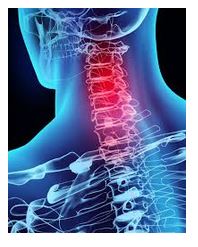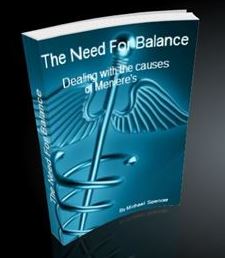Chiropractics for Meniere’s disease
Posted Under: General Information on Meniere's Disease / Syndrome,Meniere's Disease Triggers & Causes
Chiropractics for the symptoms of Meniere’s disease
Table of Contents
You can find several posts on this blog regarding the use of Chiropractics for Meniere’s disease and how it may help your reduce your symptoms. It may be worth visiting a reputable cervical certified Chiropractor and have them check your spine and neck, to see if your symptoms are cervical in origin. A significantly sizable enough number of sufferers have contacted Meniere’s Help over many years and reported significant improvements with their symptoms after treatment for this to be ignored or dismissed.
Chiropractic Rehabilitation in the Treatment of Dizziness
By Donald Murphy, DC, DACAN and Craig Liebenson, DC

Dizziness is a common complaint in the chiropractic office. It is a generic term that must be clearly defined and its cause properly characterized and diagnosed for appropriate treatment to be implemented.
It is a complaint that is often treatable via chiropractic manipulative and myofascial/rehabilitative procedures.
The first stage in the workup of a complaint of dizziness is to accurately identify the actual nature of the symptom. There are essentially four symptoms that can be described by a patient as being “dizziness.”
lightheadedness — The patient feels “not right in the head.”
presyncope — The patient feels “faint.”
disequilibrium — The patient feels off balance, often as if they are being “pulled to one side” and feels as if they could easily fall over.
vertigo — The patient feels as if they are spinning or the world is spinning around them. This can often occur in acute attacks, or it can be a constant, low level feeling. This can be rotatory or can occur in a sagittal plane.
Karel Lewit, MD, one of the foremost authorities in the world on locomotor system dysfunction and its effects on equilibrium, states: “It is important to stress that a cervical factor may be present in all forms of vertigo and dizziness … in no field is manipulation more effective than in the treatment of disturbances of equilibrium.”1
Because the entire locomotor as well as vestibular and visual system is involved in the regulation of equilibrium, all factors must be considered in the patient who suffers from disorders of this system. Michel Norre, noted authority in the field of vertigo and disequilibrium, states: “The dysfunction causing vertigo concerns the total balance function and not the inner ear function alone.”2 The types of dizziness that are generally most likely to fall into the chiropractic rehabilitative realm are disequilibrium and vertigo.
Disequilibrium is most often cervical in origin, as has been demonstrated by Hulse.3 It has been shown in several studies that the cervical spine plays a very strong role in the body’s regulation of equilibrium sense.4-7 In fact, Guyton7 states that the cervical spine plays the most important role in this regulation. One test that can be useful in determining whether a complaint of disequilibrium is of cervical origin is Hautant’s test.1 Have the patient sitting, preferably in a chair with back support to prevent falling, and holding their arms straight out in front of them, palms down. Have them close their eyes and observe for drifting of their arms to one side. Repeat this with the head turned to the right and to the left and often the deviation will become more marked, particularly when the head is turned to the direction of cervical joint dysfunction. This tests the ability of the cervical spine to appropriately regulate muscle tone in the extremities by properly eliciting the tonic neck reflexes.
Vertigo, as stated earlier, is by definition an abnormal sensation of movement, usually spinning. Attacks of vertigo can be elicited by various maneuvers or can be constant. When the vertigo is caused by Meniere’s disease it is accompanied by unilateral tinnitus and hearing loss. Benign positional vertigo is caused by dysfunction of the labyrinthine apparatus in the inner ear and attacks are elicited by changes of head position in space, as can be tested for utilizing the Barany maneuver. Cervicogenic vertigo also occurs in attacks and these attacks are elicited by changes of head position relative to the trunk. This can be tested for by utilizing the rotating stool test,8 wherein the patient sits on a stool that has the ability to rotate and is told to rotate their entire body from side to side while the doctor holds their head in position, thus restricting movement to the cervical spine and avoiding stimulation of the inner ear mechanism. If this elicits an attack of vertigo, it is most likely of cervical origin.
Vetebrobasilar insufficiency can cause vertigo, though with this disorder the vertigo almost never occurs by itself, rather being generally accompanied by other symptoms of brainstem ischemia, such as numbness in the ipsilateral face and/or contralateral body; nausea; vomiting; loss of consciousness; visual problems; difficulty walking; incoordination of the extremities; tinnitus; speech problems and nystagmus. The symptoms can be provoked by rotation of the cervical spine, although this is not always the case, and there may be a history of TIA. Vertigo caused by other brainstem diseases such as CP angle tumor can cause a constant, low intensity vertiginous sensation that increases in intensity as the tumor grows.
So it can be seen that before a referral or management strategy can be formulated, there must be accurate diagnosis of the cause of the disequilibrium or vertigo. There are various treatment/rehabilitative approaches that can be taken to restore normal function and eliminate the complaint.
When vertigo or disequilibrium is caused by dysfunction in the cervical spine or labyrinythine apparatus, it is most often treatable in the chiropractic setting. Optimum function of the cervical spine is essential to the recovery from these disorders regardless of the cause. Lewit10 showed that patients with Meneire’s syndrome can be effectively treated with manipulation, demonstrating that 79 percent of 21 cases showed an “excellent” outcome. Fitz-Ritson8 showed that patients with posttramatic vertigo of cervical origin treated with chiropractic manipulative, myofascial and rehabilitative procedures experienced a 90.2 percent success rate. Treatment must not only be directed towards the correction of joint dysfunction via manipulation, but must also be directed toward muscular dysfunction, such as myofascial trigger points and muscle tightness.11 In addition, faulty movement patterns that involve the cervical spine, including cervical flexion, sit-to-stand, breathing and swallowing12 must be detected and corrected. This is especially important because often these patients will have imbalance in activity between the deep neck flexors and the upper cervical extensors. Examining for this imbalance and correcting it through rehabilitative procedures will help the patient improve locomotor system function as a whole and prevent treatment resistance and recurrence of the problem.
Meniere’s disease and upper cervical chiropractic care: Video
If you found this article and site useful Click here to support Meniere’s Help paypal.me/menieres
Related articles:
Help other sufferers. Do you have experience with chiropractics and Meniere’s disease? Tell us all about it in the comments box below or email Mike at meniereshelp@gmail.com
Further reading/references: Chiropractic Rehabilitation in the Treatment of Dizziness








Reader Comments
I would agree to a certain extent that a good chiropractor can alleviate some of the symptoms. Even those who believe in conventional medicine have started to believe that some of the conditions are resolved to some extent through such alternative treatments wherein the body’s natural energy balance is restored and overall circulation is improved.
We are having our annual national seminar next month.
I have just been told i have meniers didease. i am trying to find a list of things i can eat. without bringing on attacks of vertigo. please let me by my e mail. i just feel alone with this disorder dont get me wrong my husband is the best person in the world but there is only so much he cando.thanks pamela
And this “natural energy level” – it’s detailed in which medical text book or Anatomy text?
Talk like that is plain woo – drivel – and it’s talk like this that lines the pockets of woo practitioners and causes people to needlessly suffer trying to find a cure through ways that in reality are not there.
Arthur, me thinks you need to open your mind a little. After living in Japan for 13 year I can tell you that what we in the west consider to hokus (ie chinese medicine, acupuncture etc) you can receive on health insurance here. It’s just the same as visiting a western doctor though, some are good, some not so good so it all depends on the practitioner..as for pathways, natural energy etc….scoff all you like, unless you’ve tried it though you are in no position to dismiss it. I know of plenty of people who have had good results with Chiropractics and Menieres disease…..I remember going to a doctor in London for my back……he could’t help me except giving me painkillers…… he lent over and whispered, ” I didn’t tell you this, but visit a chiropractor ” ………so I suggest anyone reading……make your own mind up.
I’ve got bilateral Meniere’s (pron Menyaze cuz it’s French!) and had endolymphatic sac decomp surgery on both ears. Yes it helped but it’s NOT a permanent fix as the bone can regrow back which is most likely what’s happened to my right ear! Without going further with other very risky things such as gentamicin or other harsh surgeries, I’ve had to basically draw the line with conventional ENT docs as I’ve run out of options with them pretty much. So I’ve turned to alternative treatments hoping this will help me. First off, I went to a chiropractor and my cervical spine of my neck is straight and it should be curved! This is one contributing factor to my Meniere’s as I’m not getting proper nerve function and bloodflow to my head. Another factor is allergies. Permanent allergy removal by means of NAET or A/SERT using muscle stress testing/kineseology science can most definitely significantly decrease symptoms. Lymphatic drainage can also help by removing lympatic fluid pressure out and away from the ears flushing harmful toxins out of the body. Doing all this with a cold laser is the best method to take. Acupuncture can also do wonders. This is used in conjunction with everything else I mentioned above. Just depends on what all the patient can tolerate. Lastly, if you have any silver mercury amalgam fillings, GO GET THEM REMOVED ASAP and replaced with tooth-colored fillings instead! Mercury is so toxic and is a contributing factor to Meniere’s!
Thank you Julie, This is great information for everyone. You are basically backing up everything we say on here. That being that Meniere’s symptoms have a cause, sometimes more than one. It is so frustrating knowing this and seeing everyone having to go through all the conventional treatments, spending huge amounts of money (if you are in the US) and wasting time, ultimately having to prolong their suffering year after year. We know that the cause can be cervical (neck) and or amalgam among many other things. Allergies can be huge factor as you say, either as a cause or just compounding the problem once you have Menieres.
Acupuncture can help a great deal but I will say: 1. You need a good practitioner and 2. It is a treatment not a cure. We have heard only a little about lymphatic drainage but will look into it deeper, so thank you so much for your comments. Very helpful.
Everyone is different, in slightly different environments, different health conditions and health history and different lifestyles, so it is a process of elimination ticking off the possible causes until you find yours. And as you quite rightly show us here, there may be more than one cause or even one cause and as a result several triggers. This is something we have been spending a LOT of time on over the past few years.
Thanks again and we would love to hear about your progress as you go along. Either post on here or email us at: meniereshelp@gmail.com
Checking back in after a month and I’m not much better just yet. Although I haven’t had any more vertigo since June 1st, knock on wood, I still feel it trying to let itself in and wreak havoc on me! I am in the midst of NAET treatments and subluxation correction of my cervical neck area. I’m also taking several nutritional supplements you talk about and John of Ohio regimine. I did get my mercury fillings removed and replaced with safe fillings and noticed some difference but not significant enough although that may be taking some time for my body to get used to not having those in my teeth either. But I’m not giving up by any means as I still have a ways to go yet. I am hopeful the NAET practitioner will pinpoint which allergens are causing my cochlea to swell up so he can clear my body of them. Yes I hate that this takes time but I feel my patience will pay off! But if for some reason NAET doesn’t quite get it done, I will have to resort back to surgery on my right ear as I feel the bone I had removed has most likely regrown back. Unfortunately there’s no scan to detect this. Yall stay tuned for another update!
Hi Julie,
Thanks for this. I would just like to say, it is not a good idea to mix the supplements we take with other supplements, unless they are completely different such as the Lipoflavnoid . It is recommended that you never mix because it upsets the balance of what we take and can also lead to too much of certain nutrients.
If I were you I would stick with the full regimen we take OR the full regimen from John’s formula. That way you can know if one doesn’t help the other may do. Of course I know the regimen we take works for the vast majority who do take them in accordance to the recommended doses. That said John is also very confident his regimen helps too. My only reservation is it can depend greatly on the quality of the supplements you buy.
If you have had your taken amalgam out, that will no doubt cause extra trauma in the short term and could even make the symptoms worse for a time.
The thing is not to give up on nutrition and not take one Chiropractors treatment as absolute. Like all practitioners of health care they are human beings and some are better than others, some have bad days and good days, some have a better history with certain conditions than others.
Thanks again for this and do keep us all up posted